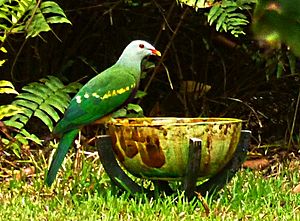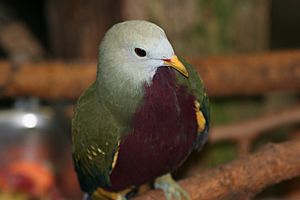Wompoo fruit dove facts for kids
Quick facts for kids Wompoo fruit dove |
|
|---|---|
 |
|
| In Queensland, Australia | |
| Conservation status | |
| Scientific classification | |
| Genus: |
Ptilinopus
|
| Species: |
magnificus
|
| Synonyms | |
|
Megaloprepia magnificus, Palumbes magnifica |
|
The wompoo fruit dove (Ptilinopus magnificus) is also called the wompoo pigeon. It is one of the bigger fruit doves. You can find it in New Guinea and eastern Australia.
Contents
About the Wompoo Fruit Dove


These doves are usually about 35 to 45 centimeters (14 to 18 inches) long. But, the ones living in northern areas are often smaller.
They have beautiful purple feathers on their neck, chest, and upper belly. Their lower belly is yellow, and their underparts are green. Both male and female doves look quite similar. Young doves, called juveniles, have duller and greener feathers than the adults.
Even though they have bright colors, they are hard to spot. They blend in well with the green forest treetops. They are also very quiet birds. Their call sounds a bit like wollack-wa-hoo. People often say it sounds very much like a human voice.
Wompoo Fruit Dove Behavior
What Wompoo Fruit Doves Eat
You might see many wompoo fruit doves together. This happens when there is lots of food available. These birds love to eat fruit from trees in rainforests. They especially enjoy different kinds of figs. Sometimes, they also eat insects.
Wompoo fruit doves can swallow large fruits whole. They are also very good at picking fruit from trees and vines. They do not like to travel far. Instead, they prefer to stay in their local area. They eat whatever fruit is in season there.
Scientists have studied what these doves eat. They can swallow fruits that are about 5 cubic centimeters (0.3 cubic inches) in size. This means they can eat round fruits that are about 2 centimeters (0.8 inches) across.
Some of their main foods include:
- Figs, especially Ficus macrophylla. This includes Ficus albipila, Ficus benjamina, Ficus drupacea, Ficus glaberrima, Ficus virens, and Ficus wassa. They eat these most often from October to March.
- Fruit from cinnamon trees (Cinnamomum sp.), Litsea, Neolitsea, and Cryptocarya. They eat these whenever they can find them.
- Palm fruit, such as Archontophoenix, Arenga, Calamus, and Caryota. These are important from August to October and in January.
- Annonaceae fruit, like Ylang-ylang (Cananga odorata) and Polyalthia. They eat these when available.
They also eat smaller amounts of fruit from:
- Eugenia, Syzygium, Acmena – important in May.
- Hypserpa – important in July and August.
- Planchonella – important from August to October.
- Elaeocarpus – important in October.
- Erythroxylon scarinatum – important in November and December.
- Tinospora smilacina, Glochidion, Gomphandra australiana, Gomphandra montana, Cayratia, Cissus, Terminalia, Diospyros, Chionanthus, Vitex cofassus, Alocasia, and Psychotria – eaten when they find them.
Wompoo Fruit Dove Reproduction
The time when wompoo fruit doves breed can change. It depends on the weather. They build a strong nest using forked twigs. They usually build their nests not too high off the ground. Both the male and female doves help to build the nest.
The female lays one white egg. Both parents take turns sitting on the egg to keep it warm. They also both help to care for the baby bird, called a chick. If a chick dies, the doves will try to have another baby in the same season.
Wompoo Fruit Dove Conservation
The wompoo fruit dove is found in many places. It is quite common throughout its large habitat. Because of this, it is listed as "Least Concern" on the IUCN Red List of Threatened Species. This means it is not currently in danger of disappearing.
See also
 In Spanish: Tilopo magnífico para niños
In Spanish: Tilopo magnífico para niños


